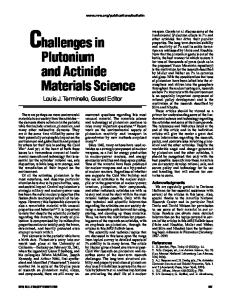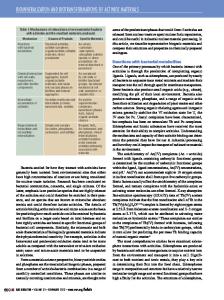Localized and Itinerant States in Actinide Materials
- PDF / 203,009 Bytes
- 6 Pages / 612 x 792 pts (letter) Page_size
- 118 Downloads / 514 Views
0986-OO01-04
Localized and Itinerant States in Actinide Materials J. J. Joyce1, T. Durakiewicz1, C. G. Olson2, E. Guziewicz3, K. S. Graham1, D. P. Moore4, and L. A. Morales4 1 Condensed Matter & Thermal Physics Group, Los Alamos National Laboratory, Los Alamos, NM, 87545 2 Iowa State University, Ames Laboratory, Ames, IA, 50011 3 Institute of Physics, Polish Academy of Sciences, 02-668, Warszawa, Poland 4 Materials Science and Technology Division, Los Alamos National Laboratory, Los Alamos, NM, 87545
ABSTRACT The electronic structure of single crystal UO2 and polycrystalline δ-Pu is examined using photoelectron spectroscopy. These two actinide materials exhibit properties consistent with the 5f electrons at the threshold between localized and itinerant character. The results for δ-Pu may be viewed as the 5f electrons exhibiting a dual nature with some fraction of the 5f levels localized and not participating in the bonding while the other fraction of 5f character is involved in bonding and hybridization with the conduction electrons. For UO2 where angle-resolved photoemission is available, one observes dispersion in the 5f features indicative of the 5f electrons being influenced by the periodic potential of the lattice rather than purely influenced by the site to which the 5f electrons are generally localized. INTRODUCTION While Pu defines the localized/itinerant boundary for the 5f electrons in the actinide elements, one may consider pushing earlier actinides to the localization threshold by placing the actinide in a non-f-electron matrix such as a compound or alloy. The manifestation of the localization boundary in the elements is observed in several physical properties including the Wigner-Seitz radius of the actinide elements [1] and the binary phase diagram of the actinides (or Kmetko-Smith diagram) [2]. For the actinide Wigner-Seitz radii or metallic volumes, one observes a cross-over from bonding 5f character as in the transition metals to localized character as in the rare earths. The bonding transition metal elements have a corresponding reduction in metallic radius as more bonding electrons are added in accordance with a Friedel-type model [3] while the non-bonding 4f electrons in the rare-earths show a nominally invariant radius across the series. For the actinide elements, a cross-over point from localized to bonding character occurs at Pu. The phase diagram of the actinides also indicates interesting characteristics converging on Pu in the actinide series. For the early portion of the actinide binary phase diagram, one finds a reduction in symmetry of the alpha phase crystal structure, a reduction in the elemental melting temperature, and an increase in the number of solid-state phases. Plutonium metal is at the epicenter of these unusual characteristics with six solid-state allotropes, a low symmetry monoclinic crystal structure, and a low melting point of 640 C. In addition to the aforementioned physical properties (metallic volume, allotropes, melting point, crystal structure), there is spectroscop
Data Loading...









